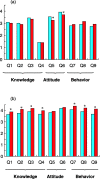An experimental trial to establish risk communication as a tool to decrease the risk by exposure to multiple chemicals for the future generations
- PMID: 29699211
- PMCID: PMC5904677
- DOI: 10.1007/BF03016139
An experimental trial to establish risk communication as a tool to decrease the risk by exposure to multiple chemicals for the future generations
Abstract
Background: Recently, it has become clear that fetuses are exposed to multiple chemicals and environmental contaminants. However, it has been reported that allergies among young children have been increasing rapidly in the last few decades, and some congenital anomalies are also increasing. There is no evidence to connect these facts directly, however if adverse health effects are caused by environmental reasons, it could be prevented by early education or risk communication. Methods: The authors gave lectures to students at a high school and universities, and carried out a questionnaire survey before and after the lectures to see the change of the students' knowledge, attitude and behavior. The total number of high-school students and university students was 47 and 605, respectively. Results: It became clear that all the levels of knowledge, attitude and behavior were elevated, and they were more elevated among high school students than university students. It was suggested that risk communication at a younger age is important to elevate people's attention and motivate them, and eventually prevent their future health risk from environmental contaminants. Conclusion: Risk communication at a young age would be more effective in increasing students' knowledge, attitude and behavior. (Reprod Med Biol 2005; 4: 65-70).
Keywords: education; environmental contaminants; high‐school students; risk communication; university students.
Figures

 ) before and (
) before and ( ) after the lecture.
) after the lecture.
 ) Male, (
) Male, ( ) female. *P < 0.05, versus male.
) female. *P < 0.05, versus male.
 ) university students (US) and (
) university students (US) and ( ) high‐school students (HS). (a) Average points before the lecture, (b) average points after the lecture. *P < 0.05, versus US.
) high‐school students (HS). (a) Average points before the lecture, (b) average points after the lecture. *P < 0.05, versus US.Similar articles
-
Implication for student's sex education in Korea.Ingu Pogon Nonjip. 1989 Jul;9(1):148-81. Ingu Pogon Nonjip. 1989. PMID: 12342602
-
Correlates of condom use and number of sexual partners among high school adolescents.J Sch Health. 1993 Feb;63(2):91-6. doi: 10.1111/j.1746-1561.1993.tb06087.x. J Sch Health. 1993. PMID: 8479165
-
A Survey on Knowledge, Prevention, and Occurrence of Sexually Transmitted Infections among Freshmen from Four Italian Universities.Int J Environ Res Public Health. 2022 Jan 14;19(2):897. doi: 10.3390/ijerph19020897. Int J Environ Res Public Health. 2022. PMID: 35055720 Free PMC article.
-
The school-based approach to teen pregnancy prevention.Plan Parent Rev. 1986 Spring;6(2):8-10. Plan Parent Rev. 1986. PMID: 12314492
-
Why do students skip classroom lectures: A single dental school report.BMC Med Educ. 2021 Jul 20;21(1):388. doi: 10.1186/s12909-021-02824-3. BMC Med Educ. 2021. PMID: 34284761 Free PMC article.
Cited by
-
Establishment of sustainable health science for future generations: from a hundred years ago to a hundred years in the future.Environ Health Prev Med. 2009 Jan;14(1):1-6. doi: 10.1007/s12199-008-0051-z. Epub 2008 Oct 8. Environ Health Prev Med. 2009. PMID: 19568862 Free PMC article.
References
-
- Todaka E, Mori C. Necessity to establish new risk assessment and risk communication for human fetal exposure to multiple endocrine disruptors in Japan. Congenit Anomal Kyoto 2002;. 42: 87–93. - PubMed
-
- Mori C. Possible effect of endocrine disruptors on male reproductive function. Acta Anat Nippon 2001;. 76: 361–368. - PubMed
-
- Mori C, Komiyama M, Adachi T et al. Application of toxicogenomic analysis to risk assessment of delayed long‐term effects of multiple chemicals, including endocrine disruptors in human fetuses. Environ Health Perspectives 2003;. 111: 803–809. - PubMed
-
- Center for Evaluation of Risks to Human Reproduction (CERHR). Available from: URL: http://cerhr.niehs.nih.gov/aboutCERHR/index.html
-
- National Academy of Sciences. Pesticides in the Diets of Infants and Children. Washington: D.D. National Academy Press, 1993. - PubMed
LinkOut - more resources
Full Text Sources
